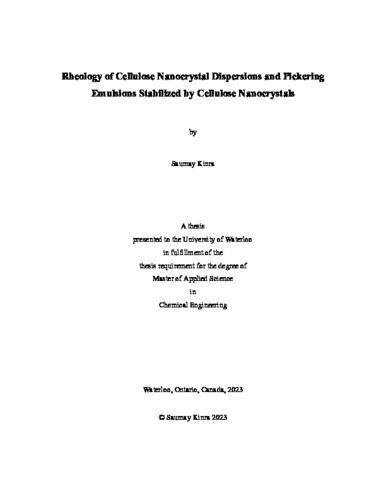| dc.description.abstract | Dispersions and Emulsions are prevalent in our society and can be seen in various applications and industries. These include: (a) the food industry, for various products such as mayonnaise, salad dressings, sauces, and ice cream, (b) the pharmaceutical industry, in drug delivery systems which include both oral and topical medications and (c) many different industrial processes, such as metalworking, lubrication, and cutting fluids. The rheology of emulsions is dependent on a series of factors, including but not limited to droplet size, particle interactions, oil volume fraction, shear rate and salt concentration. Utilizing nanoparticles to create emulsions introduces distinctive rheological properties due to their exceedingly small size and expansive surface area. The nanoparticles of choice used in this study are cellulose nanocrystals (CNCs).
This study investigates the rheology of oil-in-water emulsions (O/W) that are stabilized and thickened by cellulose nanocrystals; also known as nanocrystalline cellulose (NCC). This was investigated over a large range of NCC and oil concentrations. The NCC concentrations varied from 1.03 to 7.41 wt% (weight percent) and the oil concentrations of the emulsions varied from approximately 10 to 70 wt% (weight percent). In the process of making these emulsions, NCC dispersions were made for which a rheological analysis was done as well. Various properties such as the physical appearance, stability, droplet size, and the rheological behaviour were studied as a function of concentration, time, and shear rate in this thesis.
The study indicates that the emulsions produced were highly stable over a period of time with respect to creaming and coalescence. At higher concentrations, the emulsions behaved as non-Newtonian fluids, due to the fact that they exhibited strong shear-thinning behaviour. The rheological data were described using an existing power-law model which introduced two variables: the consistency index (K) and the flow behaviour index (n). These two variables for the emulsions were strongly dependent on the NCC and oil concentrations. Upon fixing the oil concentration, it was observed that the consistency index increased, and the flow behaviour index decreased with an increase in NCC concentration. Similarly, upon fixing the NCC concentration, it was observed that the consistency index increased, and the flow behaviour index decreased with an increase in the oil concentration. | en |

